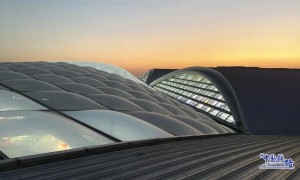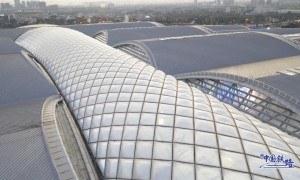作者注:本文介绍美国首例大规模应用模块化概念实施建造的医院的设计及建造过程,包括参与方的回顾性总结。
The Miami Valley Hospital cardiac center, currently nearing completion in Dayton, Ohio, is a 500,000-sf, 12-story addition that will provide state-of-the-art diagnostic and treatment services to the region. When it opens in a few months, the $137 million facility arguably will become the first major hospital project in the U.S. to have made extensive use of prefabricated components in its design and construction.
位于俄亥俄州代顿的迈阿密谷医院心脏中心(Miami Valley Hospital cardiaccenter)目前已接近完工,它是一座占地50万平方英尺、12层的新建建筑,将为该地区提供最先进的诊断和治疗服务。几个月后,这座造价1.37亿美元的医院将成为美国第一个在设计和施工中大量使用预制组件的大型医院项目。
At Miami Valley, prefabrication yielded higher quality construction, a safer work environment, and a faster construction schedule. This project raises the prospect that if prefabrication can be used successfully in a complex hospital project, it may also be a sound methodology for constructing affordable multifamily housing, college and K-12 classroom buildings, university residence halls, medical offices buildings, laboratories, hotels, senior living facilities, and other building types with numerous repetitive components.
在迈阿密谷,预制产生了更高质量的施工,更安全的工作环境,和更快的施工进度。这个项目提出了前景,如果可以使用预制医院成功地在一个复杂的项目,它也可能是一个声音的方法构建合理的多户住房,大学和中小学教室建筑大学学生宿舍,诊所建筑物、实验室、酒店、高级生活设施,和其他建筑类型与许多重复的组件。
At Miami Valley, five key component types were constructed and assembled off site:
在迈阿密谷,有五种关键的组件类型是在现场外建造和组装的:
• Patient room toilets, casework, and headwalls
•病房厕所、病例室和床头墙
• Integrated MEP racks above corridors
•集成的MEP架在走廊上方
• Modular workstations for staff
•模块化护士工作站
• Unitized curtain wall sections
•幕墙单元
• A temporary pedestrian footbridge
•临时人行天桥
The design firm, NBBJ, and construction manager, Skanska USA Building, are enthusiastic about applying what they’ve learned about prefab in Dayton to future projects.
NBBJ设计公司和Skanska美国大厦的施工经理非常热衷于将他们在代顿学到的预制材料应用到未来的项目中。
RULES OF ENGAGEMENT FOR PREFAB CONSTRUCTION
预制结构的交战规则
Modular prefabrication makes sense when the project has a sufficient number of repetitive elements—for example, 178 patient rooms, as in the Miami Valley project. According to Building Team members on that job, once that baseline is set, several best practices should kick in:
当项目有足够数量的重复元素时,模块化预制就有意义了——例如,迈阿密谷项目中有178个病房。根据在该工作上构建团队成员的经验,一旦设置了基线,就应该引入以下几个最佳实践:
1. Prefab must serve the design, not vice versa.
1. 预制必须服务于设计,而不是相反。
2. Engage key subcontractors and suppliers early in the design process.
2. 在设计过程中尽早接触关键的分包商和供应商。
3. Use BIM—without it, it’s almost impossible do prefab right.
3.使用bim -没有它,几乎不可能做好预制件。
4. Build a mockup, and test it on occupants and end-users.
4. 建立一个模型,并测试它的居住者和最终用户。
5. Employ just-in-time delivery of modules to keep the job site free of clutter.
5. 使用及时交付的模块,以保持工作现场没有混乱。
6. Make sure your modules can be delivered on conventional flatbed trucks or the equivalent. A miscalculation here could prove embarrassingly expensive.
6. 确保你的模块可以用传统的平板卡车或类似的运输工具运送。一个错误的估计可能会被证明是令人尴尬的昂贵。
Setting the stage for prefab
Three years ago, when the Miami Valley project was in preliminary design, NBBJ and Skanska independently were looking at how to ramp up use of prefab elements in building construction. NBBJ principals had just attended a seminar by James Timberlake, FAIA, founding partner of the Philadelphia architecture firm KieranTimberlake, examining how manufacturing approaches might transform building construction. The author of refabricating Architecture lit a fire under NBBJ staffers.
三年前,当迈阿密谷项目处于初步设计阶段时,NBBJ和Skanska分别研究了如何在建筑施工中增加预制构件的使用。NBBJ的校长们刚刚参加了由费城建筑公司KieranTimberlake的创始合伙人、美国建筑师协会的詹姆斯·廷伯莱克(James Timberlake)主持的研讨会,研究制造业可能如何改变建筑结构。《改造建筑》的作者在NBBJ的员工手下点燃了一把火。
Around the same time, interest in prefab was percolating at Skanska. The construction management firm already had a couple of prefab-intensive hospital projects under way in the United Kingdom, and Skanska managers here were eager to try it on this side of the pond.
大约在同一时间,在Skanska,人们对预制装配式的兴趣也在慢慢渗透。这家建筑管理公司在英国已经有了几个预制密集型的医院项目,Skanska的经理们也很想在英国尝试一下。
At an early process design charrette with the owner, Tim Fishking, AIA, NBBJ’s principal-in-charge, says he and Marty Corrado, Skanska’s project executive on the job, had one of those moments when the proverbial light bulb went on over their heads and prefab seemed to make sense for the project.
在流程设计与业主专家研讨会议,蒂姆•Fishking友邦,NBBJ principal-in-charge,说他和马蒂拉在建的项目执行工作,有一个众所周知的灯泡的时刻继续在他们的头上,组合式似乎有意义的项目。
However, for Bob Eling, director of strategic construction for Premier Health Partners, the owners of Miami Valley Hospital, prefab represented a radical departure from established construction practices. Only after a tour of Skanska’s prefab hospital projects in London in the fall of 2008 was he reassured that prefab could work in Dayton.
然而,对于迈阿密谷医院(Miami Valley Hospital)所有者Premier Health Partners的战略建设主管鲍勃•埃林(Bob Eling)来说,预制装配式住宅代表着对既定建筑惯例的彻底背离。2008年秋,在参观了Skanska位于伦敦的预制装配式医院项目后,他才打消了在代顿使用预制装配式医院的疑虑。
When he took the case for prefab to his management, Eling was pleased to find them open to the idea. “They wanted to know the usual: ‘Are we going to get the job done, and how much will it cost?’” he recalls. His main selling point: trust. “We had worked with Skanska on another job, and we had faith in them
当他把预制装配线的案例提交给管理层时,艾林很高兴地发现他们对这个想法持开放态度。他们想知道通常的情况:我们能完成这项工作吗?要花多少钱?他回忆道。他的主要卖点是:信任。我们和Skanska一起做过另一份工作,我们对他们有信心
THINKING ‘PREFAB’ LEADS TO HIGH-FLYING BRIDGE SOLUTION
“预制”的思想导致了桥梁的解决方案
Three buildings had to be demolished to make room for the new addition, which created the need for a temporary bridge to maintain pedestrian circulation between buildings during construction. A conventional bridge would have cost $2.1 million and taken several months to build. Instead, the Building Team came up with a unique solution: have an airport jetway vendor build it. JBT AeroTech built the bridge in five sections using an off-the-shelf design. Workers on site poured the foundations, set the sections in place, and connected them in just three days, with no disruption to pedestrian traffic. The cost: $980,000.
为了给新增加的建筑腾出空间,必须拆除三座建筑,这就需要在建筑期间建造一座临时桥梁来维持建筑之间的行人交通。一座传统的桥梁需要花费210万美元,耗时数月才能建成。相反,构建团队提出了一个独特的解决方案:让机场通道供应商构建它。JBT AeroTech使用现成的设计,将桥梁分为五个部分。工人们在现场浇筑地基,将各部分固定好,并在三天内将它们连接起来,没有干扰行人交通。成本:980000美元。
“We wanted to use part of the bridge for a connection between one building and the parking garage,” said Premier Health Partners’ Bob Eling. But the permanent footbridge had to have glass on both sides, and the jetway had glass on only one side. Retrofitting it would have been more expensive than building one from scratch.
我们想用桥的一部分来连接一座建筑和停车场,Premier Health Partners的Bob Eling说。但是永久性的人行桥两边都要装玻璃,而高速公路只有一边装玻璃。改造它要比从头开始建造更贵。
Putting prefab in perspective
正确看待预制板
NBBJ’s Fishking is quick to point out that prefabrication did not rule the design process. The chief programmatic concerns were to provide high-quality construction and a facility that met the needs of staff and patients. “When we got to a certain point of understanding the function, operation, and aesthetics, we started to look at prefabrication,” he says. “We didn’t develop the components to try to jam them into a prefab box.”
NBBJ的Fishking很快指出,预制并没有主导设计过程。项目的主要关注点是提供高质量的建筑和满足工作人员和患者需求的设施。“当我们对功能、操作和美学有了一定的了解后,我们开始关注预制构件,”他说。“我们开发这些部件并不是为了把它们塞进预制盒里。”
“Prefab must serve the design,” says NBBJ senior associate Ryan Hullinger, the lead designer on the project. Once the design parameters were established, however, it became clear that there would be a number of opportunities for using prefabrication.
“预制板必须服务于设计,”NBBJ的高级助理瑞安·胡林格(Ryan Hullinger)说,他是这个项目的首席设计师。然而,一旦确定了设计参数,就会清楚地看到有许多使用预制构件的机会。
As it turned out, the actual design of the modules became largely a function of the means by which they would be transported from the manufacturing plant to the job site. In order to avoid the cost and hassle of securing special permits for oversize loads, it was determined that all components had to fit on a standard flatbed truck. The designers also had to take into account the weight and bulk of the components, so that onsite workers could readily hoist the units and put them in place.
结果是,这些模块的实际设计很大程度上取决于它们从制造工厂到现场的运输方式。为了避免为超大型货物取得特别许可证的费用和麻烦,决定所有部件必须安装在一辆标准的平板卡车上。设计人员还必须考虑到组件的重量和体积,以便现场工作人员能够方便地吊起组件并将其放置到位。
批注:脱离建筑研究预制技术无异于无根之木
These physical factors led to a decision that may look obvious in retrospect but took some clever thinking at the time: split the bladelike walls dividing patient rooms into three parts—a toilet unit, a headboard, and a casework unit—and use factory-built MEP racks as well.
这些物理因素导致了一个决定,这个决定在回想起来可能是显而易见的,但在当时做了一些聪明的思考:把像刀片一样的墙壁分成三个部分——卫生间、床头板和案件间——并使用工厂制造的MEP支架。
Manufacturing the components
制造的组件
Once the decision to use prefabricated components was made, NBBJ went searching for suitable off-the-shelf bathroom modules—to no avail. “We couldn’t find anything that met our standard for quality,” says NBBJ’s Hullinger. They had no better luck finding modular MEP racks. The Building Team quickly realized that there was only one way these elements could be made: Skanska and its subcontractors would have to manufacture them themselves.
一旦决定使用预制组件,NBBJ就开始寻找合适的现成浴室组件,但毫无效果。“我们找不到任何符合我们质量标准的东西,”NBBJ的胡林格说。他们没有更好的运气找到模块化的MEP机架。建筑团队很快意识到,只有一种方法可以制造这些元素:Skanska及其分包商必须自己制造。
Skanska rented an old furniture warehouse less than three miles from the hospital as the fabrication plant. Before ramping up the assembly line, workers constructed a bathroom mockup at the warehouse. Nurses and other hospital professionals critiqued the design; as a result of their input, certain fixtures were repositioned to make patient care and maintenance easier.
Skanska在离医院不到三英里的地方租了一个旧家具仓库作为工厂。在装配流水线之前,工人们在仓库里建了一个浴室模型。护士和其他医院专业人员对该设计提出了批评;由于他们的输入,某些固定装置被重新定位,使病人的护理和维护更容易。
All components were custom-assembled and constructed using conventional building materials. Tradespersons assembled the patient room “blades”—the room-dividing walls and bathrooms for 178 patient rooms—and the overhead MEP racks. All metal studs, ductwork, conduits, and pipes were ordered to length, reducing waste material almost to nothing. The 8×22-foot MEP racks were built to fit within 16-foot-wide corridors that spanned five patient-room floors.
所有部件都是用传统建筑材料定制组装和建造的。商人们组装了病房的“刀片”——178间病房的分隔墙和浴室——以及头顶上的MEP支架。所有的金属螺柱、管道系统、导管和管道都被要求加长,几乎将废料减少到零。这些8×22英尺的MEP支架安装在16英尺宽的走廊里,走廊横跨五层病房。
Exactly how the blades and overhead racks would be lifted and placed in the building was something that the contractor determined after the modular components were built. “We had to figure out how we were going to rig these components and fly them into the building,” Corrado says. “We took them to a truck stop to have them weighed so we would know how much weight we were hanging off of the steel.”
叶片和高架架将如何吊起并放置在建筑中,这是承包商在模块组件建成后确定的。Corrado说:“我们必须弄清楚如何装配这些部件,然后把它们飞进大楼。”“我们把它们带到一个卡车站称重,这样我们就能知道悬挂在钢架上的重量。”
With little room at the construction site to store components, workers employed just-in-time delivery of the modules from the warehouse to the hospital. Crews built a custom dolly to position the blades after they were lifted into the building. Notches were sunk into patient floors exactly where the bathroom modules were placed—an instance where precision was critical.
由于建筑工地几乎没有空间存放零部件,工人们只能及时将这些模块从仓库运到医院。工作人员做了一个自定义的小车,以定位叶片后,他们被提升到建设。病人地板上的凹槽正好是放置浴室模块的地方——这是一个精度至关重要的例子。
Another key area for prefabrication was the curtain wall. “Unitizing the curtain wall is not new, but we took the next step by having closer coordination with the curtain wall subcontractor,” Fishking says. NBBJ adopted a design-assist relationship with the fabricator. “This is very different from design-bid-build,” says Hullinger. “Here, the fabricator was brought into the design process and their knowledge of construction techniques was readily available to us. The result was a better design.”
另一个关键的预制区域是幕墙。“统一幕墙并不新鲜,但我们采取了下一步,与幕墙分包商进行了更密切的协调,”Fishking说。NBBJ采用了与制造商的设计辅助关系。“这与设计-投标-建造有很大的不同,”Hullinger说。“在这里,制造者被引入设计过程,他们的施工技术知识对我们来说很容易获得。结果是一个更好的设计。”
Modular curtain wall construction also greatly increased the speed to getting the building enclosed. “This is especially important on a site where you don’t have a lot of space to store materials,” says Fishking.
模块化的幕墙结构也大大提高了建筑围合的速度。Fishking说:“对于一个没有足够空间储存材料的项目来说,这一点尤其重要。”
BIM AIDS ACCURACY, PRECISION, PROBLEM-SOLVING
BIM帮助准确性、准确性、解决问题
In any building project that makes extensive use of prefabrication, modular elements have to be largely complete when put in place and must fit precisely into the structure—on-site alterations are a no-no. That’s why competence with BIM has to be pretty much a given for any Building Team using a lot of prefab components. Skanska and subcontractors TP Mechanical, Dalmatian Fire Protection, and Chapel Electric used Autodesk Navisworks to coordinate design and construction of the MEP systems.
在任何广泛使用预制构件的建筑项目中,模块化元素必须在到位时基本完成,并且必须精确地适应结构——现场更改是一个禁忌。这就是为什么BIM的能力对于任何使用大量预制构件的建筑团队来说都是必须的。Skanska和分包商TP Mechanical、Dalmatian Fire Protection和Chapel Electric使用Autodesk Navisworks来协调MEP系统的设计和施工。
According to NBBJ principal-in-charge Tim Fishking, AIA, using BIM not only improved accuracy and precision, it also “greatly enhanced” the team’s ability to solve the design problems associated with the components.
据NBBJ的负责人Tim Fishking, AIA所说,使用BIM不仅提高了准确性和精度,还“极大地增强了”团队解决与组件相关的设计问题的能力。
Results vindicate the prefab approach
结果证明了该方法的正确性
As the project nears completion, the advantages of the prefab approach—particularly improved construction quality and greater precision—are becoming more and more apparent.
随着工程接近完工,预制方法的优势——特别是提高了施工质量和更高的精度——变得越来越明显。
“In conventional construction, no matter how well your design is coordinated, that can slip during field construction,” says NBBJ’s Hullinger. With prefabrication, “You can develop elaborate, well-coordinated 3D models that show the location of every pipe, duct, and beam. Overhead racks look exactly like they were modeled. That’s remarkable.”
“在传统的建筑中,无论你的设计如何协调,在现场施工时可能会出现滑动,”NBBJ的Hullinger说。通过预制,“你可以开发精细的、协调良好的三维模型来显示每根管道、管道和梁的位置。头顶上的架子看起来和建模时一模一样。这是非凡的。”
Having major subcontractors involved early was essential to making the prefab strategy pay off, says Premier Health’s Eling. Bids were sent out when construction drawings were just 50% complete. The subs’ input led to higher quality prefab components; the resulting accuracy of the models made installation of the MEP racks go smoothly. “We didn’t have to modify one beam pocket out of hundreds of beam pockets,” says Skanska’s Corrado says. “Same with our attachment points.”
Premier Health的Eling说,让主要的分包商尽早参与是使预制策略获得成功的关键。当建筑图纸只完成了50%时,投标就发出了。subs的输入导致更高质量的预制组件;模型的精度使得MEP机架的安装非常顺利。Skanska的Corrado说:“我们不需要从数百个光束口袋中修改一个光束口袋。”“我们的附着点也一样。”
The prefabrication process also was a boon to worker productivity. For example, a good day’s output for a plumber working above ceiling level would be about 200 feet of pipe per day. At the warehouse, output was tripled, averaging 600 feet of pipe a day—this for workers who were paid about $40 an hour, compared to $50 an hour for on-site workers.
预制过程也有利于提高工人的生产力。例如,对于一个在天花板以上工作的水管工来说,一天的产量大约是200英尺。在仓库里,产量增加了两倍,平均每天600英尺的管道,工人的工资大约是每小时40美元,而现场工人的工资是每小时50美元。
In fact, the manufacturing process was so efficient that the work on the construction site could not at times keep pace, so Skanska had to rent additional space to store the blades and MEP units until the construction crews were ready for them.
事实上,制造过程非常高效,以至于施工现场的工作有时跟不上进度,所以Skanska不得不租用额外的空间来存放叶片和MEP设备,直到施工人员准备好。
Prefab also helped accelerate the construction schedule. “You can start your interior rough-in while you’re still doing structure and foundation,” Corrado says. “We were able to do interior rough-in components in February in Ohio in a temperature-controlled warehouse instead of outside on an upper floor with the wind blowing through at zero degrees.”
预制板也有助于加快施工进度。Corrado说:“当你还在做结构和基础的时候,你就可以开始你的内部粗加工了。”“今年2月,我们在俄亥俄州的一个温度控制的仓库里完成了内部的粗加工,而不是在外面的一层楼里,让风在0度的温度下吹过。”
There were ergonomic benefits as well. Factory workers standing on a level floor with easily accessible tools and materials were at lower risk for muscle strain than if they had had to climb up and down ladders to construct MEP racks above their heads at the job site. There were no shop injuries on the job.
人体工程学也有好处。工厂工人站在平整的地板上,拿着容易拿到的工具和材料,与他们必须爬上爬下才能在工地头顶上搭建MEP架相比,肌肉拉伤的风险更低。工作中没有商店人员受伤。
Eling sums up the advantages of prefab in three words: schedule, safety, and quality. Although there were also some cost savings associated with prefabrication—notably more than $1 million on the temporary footbridge—prefabrication didn’t provide a huge overall project cost savings on the $137 million project, Eling says. Prefabbed components touched only about 11% of total construction costs.
Eling用三个词来概括预制的优点:进度、安全性和质量。埃林说,虽然预制工程也节省了一些成本,特别是在临时人行桥上节省了100多万美元,但预制工程并没有为这个耗资1.37亿美元的项目带来巨大的整体成本节约。预制组件仅占总建筑成本的11%左右。
Down the line, however, hidden savings could emerge. “The MEP racks on the five patient floors are identical,” Eling notes. “All of the ductwork, dampers, sprinkler piping, medical gases, and offshoots to patient rooms were constructed identically and positioned the same way on each floor. In the future, maintenance personnel will know exactly where to go to work on them.” The MEP racks also were constructed with extra room to add infrastructure, as needed.
不过,未来可能会出现隐性储蓄。“五层的MEP架子是一样的,”埃林说。“所有通往病房的管道系统、阻尼器、洒水管道、医疗气体和分支都是相同的结构,并以相同的方式布置在每一层。在未来,维修人员将确切地知道在哪里使用它们。“根据需要,MEP机架还增加了额外的空间来增加基础设施。
Looking toward the prefab of tomorrow
期待着明天的预制板
“Early on, we had many of our people that thought this process was too far-fetched to try on a big hospital project,” Corrado says. Doubts faded once the skeptics were able to tour the manufacturing facility and, later, when installation of prefab components in the building worked as intended, Corrado says.
Corrado说:“早期,我们有很多人认为这个过程太牵强,不适合在大型医院项目中进行尝试。”科拉多说,当怀疑论者能够参观工厂,以及后来在大楼里安装预制组件按计划工作时,怀疑就消失了。
Skanska management has taken note of the results at Miami Valley. Skanska project teams must now submit a prefabrication plan to their area managers for consideration on all U.S. projects, according to Corrado.
Skanska管理层已经注意到了迈阿密谷的结果。科拉多表示,Skanska项目团队现在必须向区域经理提交一份预制计划,供其考虑所有美国项目。
The Miami Valley project proved that prefabrication can work in a complex building setting. In the future, Building Teams would be well advised to investigate how prefabrication might be applied to any structure with repetitive features. The benefits are too compelling to ignore.
迈阿密谷项目证明了预制可以在复杂的建筑环境中工作。在未来,建筑团队最好研究如何将预制应用于任何具有重复特征的结构。这些好处是不容忽视的。
WHAT THIS BUILDING TEAM LEARNED ABOUT PREFAB (AND WHAT THEY SAY THEY’LL DO BETTER NEXT TIME)
这个建筑团队从预制件中学到了什么(以及他们说下次会做得更好)
The Miami Valley Hospital project was a prefabrication proving ground for NBBJ and Skanska. Based on what they learned, here’s what project managers from these companies say they would do differently on future projects:
迈阿密谷医院项目是NBBJ和Skanska的预制试验场。根据他们所学到的,以下是来自这些公司的项目经理所说的他们在未来的项目中会采取的不同做法:
1. Look for more off-the-shelf options.
1. 寻找更多现成的选择。
At the start of the project in 2007, the designers could not find off-the-shelf bathroom modules that met their criteria, but that’s no longer the case, as manufacturers are responding with new and better products. “The market is moving fast, and vendors are trending toward products that we could be pretty excited about on future projects,” says Ryan Hullinger, NBBJ lead designer.
在2007年项目开始时,设计师们找不到符合他们标准的现成浴室模块,但现在情况不同了,因为制造商们正在用新的更好的产品来回应。NBBJ首席设计师瑞安•胡林格(Ryan Hullinger)表示:“市场发展迅速,供应商正趋向于推出我们在未来项目中可能会感到相当兴奋的产品。”
2. Strive for just-in-time production.
2. 争取准时生产。
Now that Skanska has a good handle on how long it takes to construct prefab modules, scheduling can be better coordinated. “We would do more just-in-time production of the modules so that we could get a much smaller place for the prefab work, which would be cheaper,” says Marty Corrado, Skanska project executive.
既然Skanska已经很好地掌握了构建预制模块所需的时间,那么调度就可以更好地协调。Skanska项目主管马蒂•科拉多(Marty Corrado)表示:“我们将更多地进行模块的准时化生产,这样我们就能获得一个小得多的预制空间,成本也会更低。”
3. Prefab modules can be more finished products.
3.预制模块可以有更多的成品。
With a better handle on prefab production schedules, modules could be fabricated with a higher degree of finishes. Research labs, exam rooms in medical buildings, kitchenettes, and other spaces could be prefabricated in a more completed state, the Building Team members feel.
有了更好的预制装配式生产计划,模块可以用更高程度的饰面制作。建筑团队成员认为,研究实验室、医疗大楼的检查室、小厨房和其他空间可以预制成更完整的状态。
4. Apply prefab to more complex components.
4. 将预制组件应用于更复杂的组件。
At Miami Valley, design of prefabricated MEP racks was kept fairly simple; only straight sections were constructed in the fabrication plant. In the future, Skanska’s Corrado says he would like to take on more complex prefabricated systems, such as intersecting corridor sections. Spaces that are laden with high-tech infrastructure may also be good prefab candidates. “In an operating room that we’re developing now, the ceiling is very technology intensive, so we’re looking at how components in that ceiling could be built offsite,” he says.
在迈阿密谷,预制MEP机架的设计相当简单;在制造工厂里只制造了直线段。未来,Skanska公司的Corrado说,他想要开发更复杂的预制系统,比如交叉走廊部分。充满高科技基础设施的空间可能也是不错的预制件。他说:“在我们现在正在开发的一个手术室里,天花板的技术含量非常高,所以我们正在研究如何在这个天花板里制造零部件。”
5. Consider using prefab in renovation projects.
5. 考虑在装修工程中使用预制板。
Prefab may not be just for new construction, the Miami Valley team says. “One of the interesting areas of potential is renovation work,” says NBBJ’s Hullinger. “You have the opportunity to prefabricate components before demolition begins, so that as demolition is occurring on site, components are being built off site. As soon as demolition is completed, these pieces could be inserted. You would minimize disruptions in the building and gain a lot of efficiencies.”
迈阿密谷团队表示,预制房可能不只是用于新建筑。“一个有趣的潜在领域是改造工作,”NBBJ的Hullinger说。“在拆除之前,你有机会预制构件,这样在拆除现场进行的同时,构件也在现场外建造。一旦拆除完成,这些碎片就可以被插入。这样可以最大限度地减少对建筑的干扰,提高效率。”
补充视频
视频4
视频5
视频6








